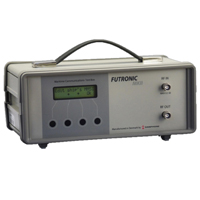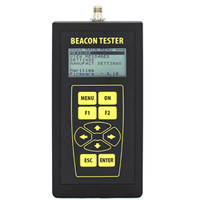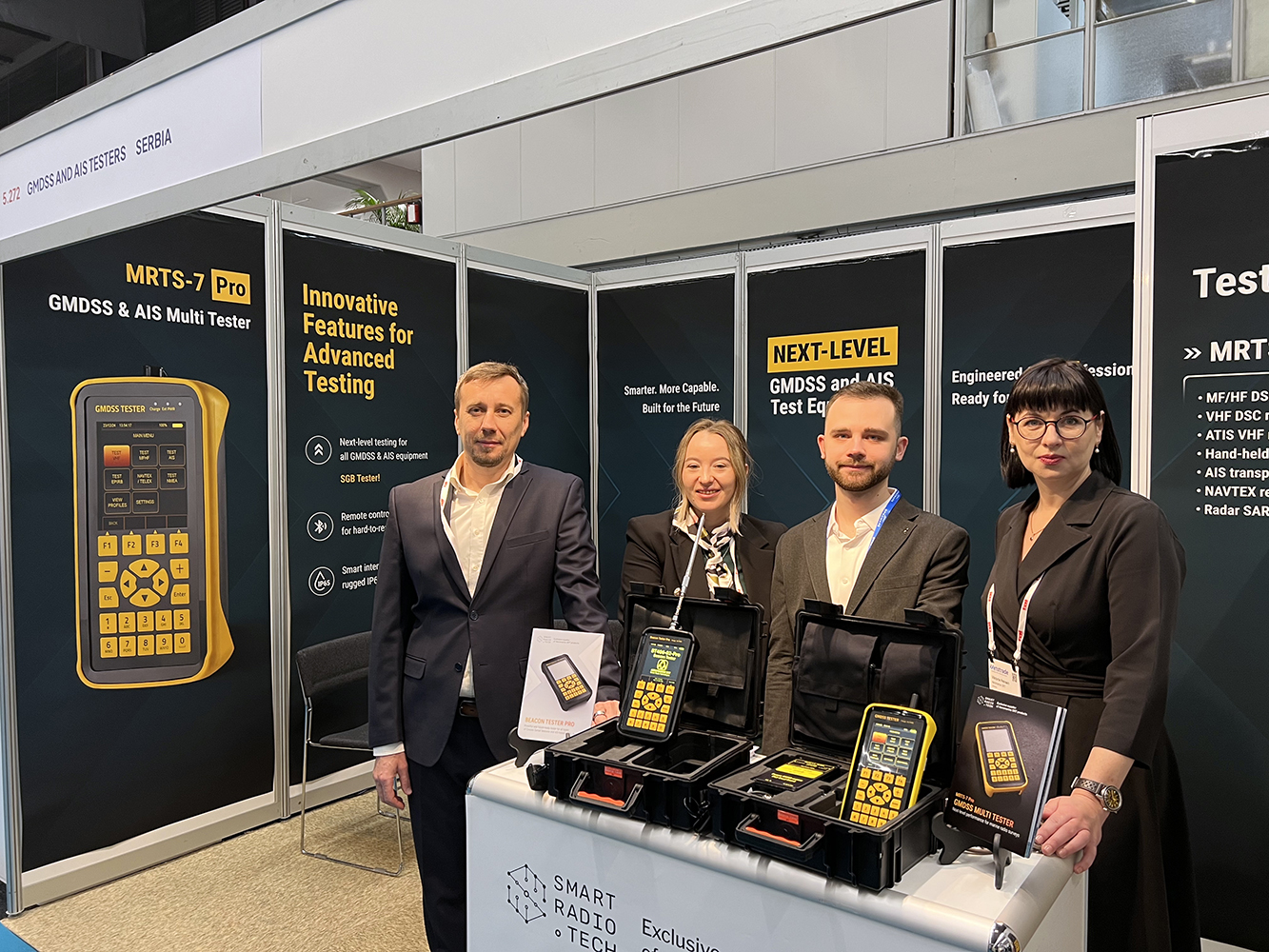Equipment for GMDSS radio surveyors. Overview of GMDSS testers available on market today
With the implementation of the GMDSS (Global Maritime Distress and Safety System), it became necessary to check the equipment that is part of this system.
GMDSS equipment must function accurately to ensure reliable communication of the vessel during its navigation in the appropriate sea areas. Its operation is checked by radio surveyors. They should have appropriate technical background, adequate knowledge of the relevant IMO performance standards, and ITU Radio Regulations.
The radio survey should be carried out using suitable test equipment capable of performing all measurements required by the IMO Resolution A.1156 (32) - Survey guidelines under the harmonized system of survey and certification (HSSC), 2021.
Marine registers recommend a wide range of test instruments that can be used for survey. Among them: frequency counter; watt meter with plug in elements covering MF, HF and VHF; ampere/volt/ohm meter; insulation resistance tester; spectrum analyzer; oscilloscope; deviation meter, etc.
In practice, inspectors prefer to use specialized devices designed to test GMDSS and AIS equipment (also mandatory for inspections). Professional testing tools perform the full scope of checks required by the IMO.
Depending on the types of maritime radio equipment being tested, the following types of testers can be identified: EPIRB testers, SART testers, AIS testers, multifunction GMDSS testers.
Here is a brief overview of what testers for professional GMDSS checks are available to radio surveyors today.
MULTIFUNCTION GMDSS TESTERS
The GMDSS multi tester is a measuring device designed to check the performance of a wide range of GMDSS equipment: VHF and MF/HF Radios with DSC, EPIRBs & PLBs, Radar-SARTs, AIS-SARTs, NAVTEX, TELEX, MoB devices. The checking also includes the AIS testing.
GMDSS multi testers are invaluable assistants for radio inspectors who conduct mandatory periodical surveys of ship’s radio equipment or safety devices; for classification societies and equipment manufacturers.
“All-in-one” testers available today are represented by models from two manufacturers. They both meet the requirements of the IMO and ITU-R for the appropriate types of equipment being tested.
MRTS-7M (Marine Radio Test Set)
- Manufacturer (country): Aeromarine SRT/former Musson Marine, Ukraine
- Year of entry into the market: 2018
- Dimensions: 100x200x45 mm, 0.44 kg
- Testing scope: MF/HF & VHF radios with DSC, EPIRBs & PLBs, Radar SARTs, AIS SARTs, AIS Class A, AIS Class B, AtoNs, AIS Base stations, MoB Devices, NAVTEX, TELEX, Pilot Plug.
- Available for purchase: yes
MRTS-7M is the first hand-held GMDSS multi tester. Radio surveyors are constantly on the move and have to carry all the equipment on their shoulders. That’s why this criteria, compactness, was very significant for the company-developer. The task is successfully implemented.
In terms of functionality, MRTS-7M performs the full scope of tests required by IMO for various types of GMDSS test equipment. Radar-SART measurements are performed using the 9 GHz SART Testing unit, which is supplied optionally.
The manufacturer has brought the quality of software to a new level. It is aimed to manage test results on PC with any operating system. All test reports are generated automatically, and the user's company logo is putting on them. Cloud online storage of surveys is available.
Futronic MKII (GMDSS AIS SART Tester)
- Manufacturer (country): Danphone (Denmark)
- Year of entry into the market: 2012
- Dimensions: 103х258х140 mm, 2.8 kg
- Testing scope: MF/HF & VHF radios with DSC, NAVTEX, TELEX, EPIRBs & PLBs, Radar SARTs, AIS SARTs, AIS Class A, AIS Class B, AtoNs, AIS Base stations, Pilot plug, MoB Devices
- Available for purchase: yes
Danish GMDSS multi testers have been on the market for almost 25 years and have proven themselves as reliable hard workers. In both generations of devices (Futronic MKI and Futronic MKII), the Danphone brand features are preserved: the classic design of the device boxes, two-line LCD display, 4 push buttons. At the same time, the Futronic MKII became more compact - it has smaller dimensions and reduced weight of the main unit (2.8 kg against 4.2 kg of Futronic MKI).
The functionality of the device has changed to a greater degree: the testing scope has extended, as well as the battery capacity. The software has been updated in accordance with the new IMO regulations for GMDSS (added new frequencies, messages, and features).
The unit performs the full scope of GMDSS radio testing required by IMO.
***
And there are also one-purpose testers that check the performance of a certain type of marine radio or safety equipment. Here's an overview of these devices.
EPIRB TESTERS
Beacon Tester 406 02
- Manufacturer (country): Aeromarine SRT/former Musson Marine (Ukraine)
- Year of entry into the market: 2018
- Testing scope: Cospas-Sarsat (406.0-406.1 MHz and 121.5 MHz channels) EPIRBs, PLBs, ELTs
- Dimensions: 195x101x43 mm, 350 g
- Available for purchase: yes
Upgraded version of the BEACON Tester 406 02 (produced in 2010-2017).
The device decodes C/S signal, measures the frequency values, power level in all channels, signal duration, calculates and compares the BCH code and finally decodes all emergency information automatically.
Accurate, independent measurements of the EPIRB parameters in a volume of:
- annual testing under IMO Resolution MSC/Circ.1040 (MSC.1/Circ.1040/Rev.1);
- shore-based maintenance under IMO Resolution MSC/Circ.1039.
The device is compatible with the latest Aeromarine SRT software. The cloud version of saving measurements and generating test reports in IMO format are supported.
BT 200
- Manufacturer (country): WST (Canada)
- Year of entry into the market: 2017
- Testing scope: Cospas-Sarsat (406.0-406.1 MHz and 121,5 MHz channels) EPIRBs, AIS-EPIRBs, PLBs, ELTs
- Dimensions: 135x70x20 mm, 222 g
- Available for purchase: yes
Based on the features of its previous version, the BT100, the BT200 offers improved measurement capabilities. This is a fully integrated and robust device. A large number of measuring capabilities in a very small package. AIS measurements have been added to the extensive list of functions of the tester.
The device allows to make all the necessary IMO measurements and much more, including in-band spectrum and frequency instability. Now the device does not require the use of an attenuator.
Waterproof rating of BT200 raised to IP68.
The tester has the most advanced features comparing to others what is completely paid by the highest price on the market.
VRI 8
- Manufacturer (country): CETC Maritime Electronics Ltd (China)
- Year of entry into the market: 2017
- Testing scope: Cospas-Sarsat (406.0-406.1 MHz and 121.5 MHz channels) EPIRBs, PLBs, ELTs
- Dimensions: 103x55x25 mm
- Available for purchase: yes
EPIRB tester from a Chinese manufacturer. The device has a small size, light weight and low power consumption. A large screen and a comfortable keyboard are other attractive features of the device.
VRI 8 is based on the Android system.
The manufacturer declared compliance with IMO requirements. The device is sold mainly on the domestic market of China.
Beacon Tester 406 Mini/WiFi
- Manufacturer (country): Aeromarine SRT/former Musson Marine (Ukraine)
- Year of entry into the market: 2016
- Testing scope: Cospas-Sarsat (406.0-406.1 MHz and 121.5 MHz channels) EPIRBs, PLBs, ELTs
- Dimensions: 83x54x19 mm, 150 g
- Available for purchase: yes
One of the most compact devices on the market that really fits in the pocket. Aluminium casing made it lightweight and damage resistant. The small form factor is achieved due to the ability to connect to any mobile device: smartphone, tablet, laptop.
All platforms are supported. The only requirements are Wi-Fi and a browser.
The device fully complies with all IMO standards and requirements. Compatible with any mobile phone or tablet.
BT 406 Mini/WiFi makes it possible to generate any type of IMO-required reports directly from the mobile phone.
It’s the most attractive device of this kind on the market at a price.
ARG 5410 MKII
- Manufacturer (country): ARG/Sartech (United Kingdom)
- Year of entry into the market: 2004
- Dimensions: 195x87x52 mm, 544 g
- Testing scope: Cospas-Sarsat (406.020-406.030 MHz and 121.5 MHz channels) EPIRBs, ELTs, PLBs
- Available for purchase: yes
ARG 5410 is one of the first EPIRB testers in the market, it was produced in 2 generations by UK companies.
The device has common features that were innovative in the beginning, but now are outdated.
The tester is still in production and available to buy (serviced by Sartech).
Tron UniDec
- Manufacturer (country): Jotron (Norway)
- Year of entry into the market: 2000
- Dimensions: 119x58x30 mm, 170 g
- Testing scope: Cospas-Sarsat (406.0-406.1 MHz) EPIRBs, PLBs
- Available for purchase: yes
Tron UniDec is a long-running series of Cospas-Sarsat EPIRB testers that has been available on the market over the past two decades. This is the first EPIRB tester that supported the entire Cospas-Sarsat frequency range: 406.000-406.100.
The model has not changed significantly over the years, either in functionality or form factor. Among beacon testers currently available on the market, only Tron UniDec requires an external computer to operate and cannot check the channel 121.5 MHz.
The model performs all the tasks required for such devices. And yet there is no doubt that Tron UniDec is an old product with quite old electrical design with the challenge of components getting obsolete.
SART TESTERS
STU-1
- Manufacturer (country): Aeromarine SRT/former Musson Marine (Ukraine)
- Year of entry into the market: 2019
- Receiver bandwidth: 9.1-9.6 GHz Radar-SART
- Dimensions: 117х76х23 mm, 105 g
- Available for purchase: yes
STU-1 is a one-purpose device designed to measure the parameters of radar-SART. It’s the latest development in this field and the only tester of such type available on the market.
The device allows to measure frequency and signal level, count the number of frequency sweeps, measure response signal duration, calculate the distance from SART along the bearing line. It visualizes the graph for frequency vs time with sweeps.
The manufacturer created a really small lightweight device, removed the LCD and keyboard (the unit needs an external PC or laptop to operate, connecting via USB), which significantly reduced the cost of the unit.
STU-1 fell into the price category demanded by the market and now radio surveyors can honestly cover the requirements of the IMO.
AIS TESTERS
AIS Tester M1
- Manufacturer (country): Aeromarine SRT/former Musson Marine (Ukraine)
- Year of entry into the market: 2018
- Supported equipment: AIS Class A and Class B stations; AIS-SARTs; AIS Base stations; AtoNs; VHF Radios with DSC
- Dimensions: 29.5x20x12.5 cm, 0.55 kg
- Available for purchase: yes
AIS Tester M1 based on SDR technology allows to perform all scope of IMO tests automatically. All the user has to do is connect it to the AIS station, run the test and take a cup of coffee while the device is completing all tests and checking the station parameters.
AIS test reports are created and printed in IMO-required format. Most of the collected and measured data are put automatically. In addition, the unit has the ability to perform testing of common VHF radios and decode DSC messages.
AIS Tester M1 is compatible with the GMDSS Tester Software Cloud Edition, a new innovative way of processing and generating test reports that makes their creation easier than ever.
OS support has been expanded: it is finally possible to connect the tester to MacBook or other Apple Mac OS devices.
AITS-R (AIS Installation Test Set. Radiated Version)
- Manufacturer (country): Sine Qua Non (South Africa)
- Year of entry into the market: 2000
- Supported equipment: AIS Class A, AIS Class B, AtoNs, AIS Base stations
- Dimensions: 20.9x10.1x4.1 cm, 0.7 kg
- Available for purchase: only as a used one (no longer in production)
The first AIS tester was developed by the South African company Sine Qua Non.
At the time when the device was designed and manufactured, there were no approved requirements for AIS, the work was carried out on the basis of draft documents of the IALA AIS Technical Working Group.
AITS-R supports all types of AIS equipment: AIS Class A, AIS Class B, AtoNs and AIS Base Stations.
It can be used as an installation test set and for checking the encoded AIS data: positional, static or voyage.
In 2007 IMO issued MSC.1/Circ.1252 Guidelines on annual testing of the automatic identification system (AIS). AITS-R did not meet all of the performance standards recommended in this document (for example, it didn’t perform the test “Check AIS response to virtual vessels”, etc).
As for the AIS health check, the tester of Sine Qua Non is quite advanced in this area.
By Olga Davydova
















Be the first to comment